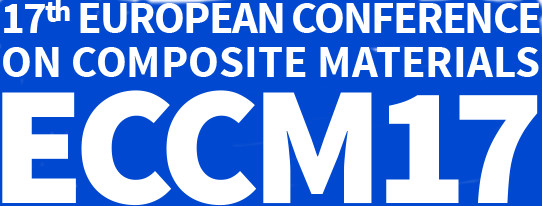

App-Einstellungen:
CYCLIC TESTING OF NOVEL CARBON FIBER BASED STRAIN SENSOR WITH SPATIAL RESOLUTION
Robin Höhne (Technical University of Dresden) Pawel Kostka (Technical University of Dresden) Niels Modler (Technical University of Dresden)
An innovative carbon fiber strain sensor based on a reversibly opening and closing of CF filament fragments is proposed. In this work, the cyclic behavior of the sensor is investigated for the first time in order to identify current limitations.
ELECTRIC CURRENT DISTRIBUTION BETWEEN A PAIR OF ELECTRODES ON OPPOSITE SURFACES OF CFRP LAMINATES
Takuya Yamane (Tokyo Institute of Technology) Akira Todoroki (Tokyo Institute of Technology) Yoshihiro Mizutani (Tokyo Institute of Technology) Yoshiro Suzuki (Tokyo Institute of Technology) Takayuki Nishi (Aerospace company, Fuji Heavy Industries Ltd.) Naoyuki Sekine (Aerospace company, Fuji Heavy Industries Ltd.) Ai Kawashima (Aerospace company, Fuji Heavy Industries Ltd.) Masahito Ueda (Nihon University)
The electric current analysis method for laminated carbon composites using orthotropic electric potential function has been newly developed for the oblique electric current flow, and verified by the comparison with numerical and experimental results.
TOWARDS MESO SCALE RESISTIVITY-BASED MONITORING OF DEGRADATION IN LAMINATED COMPOSITES
Gilles Lubineau (King Abdullah University of Science and Technology (KAUST)) Harilal Remesan (King Abdullah University of Science and Technology (KAUST)) Khaled Almuhammadi (King Abdullah University of Science and Technology (KAUST)) Lakshmi Selvakumaran (King Abdullah University of Science and Technology (KAUST)) Tushar Bera (King Abdullah University of Science and Technology (KAUST))
A practical way to track damage in laminated composites is to monitor electrical impedance. We present some fundamental homogenization relations for meso scale electrical measurement as well as some spectroscopic results on illustrative examples.
ASSEMBLED 3D PERIODIC AUXETIC CELLULAR STRUCTURE AND ITS MECHANICAL PROPERTIES
Li Ma (Harbin Institute of Technology)
An interlocking assembly manufacture method for 3D periodic auxetic cellular structures was introduced. The method has the potential for mass production and automatic manufacturing. Auxetic performance of proposed structures is investigated theoretically and numerically.
CYCLIC OLEFIN COPOLYMER/EXFOLIATED GRAPHITE NANOPLATELETS NANOCOMPOSITES FOAMED THROUGH SUPERCRITICAL CARBON DIOXIDE
Andrea Dorigato (University of Trento) Andrea Biani (University of Trento) Alessandro Pegoretti (University of Trento)
Cyclic olefin copolymer (COC) nanocomposites filled with exfoliated graphite nanoplatelets (xGnP) and foamed through supercritical carbon dioxide at different pressure levels were prepared and characterized.
DESIGN AND OPTIMIZATION OF LAYERED COMPOSITE FOAM LINERS FOR PROTECTIVE HELMETS
Yasmine Mosleh (KU Leuven) Bart Depreitere (KU Leuven) Jos Vander Sloten (KU Leuven) Jan Ivens (KU Leuven)
In this study, different configurations of layered composite foam liners for a protective helmet were studied.In addistion, the effect of using different materials as a helmet shell on the performance of a helmet in linear impact has been studied.
FABRICATION OF THE CARBON FOAMS DERIVED FROM PHENOLIC RESIN MIXED WITH MESOPHASE PITCH
Seung A Song (Chonbuk National University) Seong Su Kim (Chonbuk National University)
Carbon foams are attractive carbon materials due to their advantages such as light weight, high strength, temperature tolerance. Carbon foams have potential application such as energy absorption material, high temperature insulation.
MICROCELLULAR FOAMS FROM HIGH PERFORMANCE PEEK/PEI MISCIBLE BLENDS
Luigi Sorrentino (National Research Council of Italy) Livia Cafiero (National Research Council of Italy) Salvatore Iannace (Institute for for Macromolecular Studies)
the foamability of miscible blends based on PEEK and PEI has been investigated with the aim to find the proper conditions to develop low density microcellular foams for high performance lightweight applications.
SIMULATION OF THE HEAT TRANSFER THROUGH FIBROUS INSULATION
Andrew Webley (University of Strathclyde) Liu Yang (University of Strathclyde) David Nash (University of Strathclyde)
This paper covers the thermal modelling of a randomly orientated sample of glass fibres.
NOVEL LATTICE STRUCTURES BASED ON CONTINUOUS FIBERS: FABRICATION AND MECHANICAL PROPERTIES
Rehan Umer (Khalifa University) Hassan Jishi (Khalifa University) Wesley Cantwell (Khalifa University)
Continuous fiber lattice structures were manufactured using a lost-mold technique. Lattice structures of BCC, BCCz, FCC, F2BCC, Pyramid and Octet designs were produced. The specific compression strengths were found superior to traditional cores.
